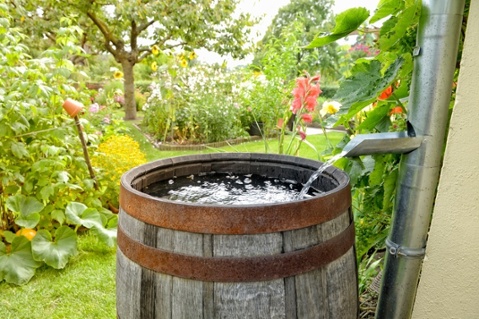 By collecting rain and storing it in a barrel or tank, homeowners can create a supply of water to use that doesn’t increase water bills or overwork groundwater resources.
By collecting rain and storing it in a barrel or tank, homeowners can create a supply of water to use that doesn’t increase water bills or overwork groundwater resources.
An additional benefit of rainwater collection is that rain doesn’t contain the minerals found in wells or the chlorine in municipal supplies. Rain collection is ideal for large water usages such as watering the lawn, washing the car, doing the laundry and showering/bathing. It is generally not used for drinking; however, it can be if properly filtered.
Understanding Rainwater Collection Systems
Collection systems range from a single rain barrel placed at the end of a gutter downspout to an elaborate system that can hold enough water to supply your entire home.
A house with a sloped roof, gutters and/or downspouts is perfect for rainwater collection intended for lawn irrigation or other non-potable uses. All that is needed is a tank, a wire/mesh gutter screen to keep debris out, and a way to remove the water from the tank.
Your tank (or cistern) can be made from a range of materials including metal, wood, stone, cement or fiberglass. Garden and home supply stores offer rain collection systems complete with your barrel, leaf screens and spouts. The costs vary, but you can expect to pay from $50 – $300 for a complete barrel system. How you plan to use it will determine the type, cost and complexity.
The easiest and most cost-effective way to remove water from your collection tank is by gravity. If you want a more elaborate use for your water, you’ll need a pump. Pumps provide about 8 gallons of water a minute up to 500 feet away.
Regulations
Homeowners should check with their homeowners association to ensure they comply with such rules as placement, color and aize of the rain barrel.
If using collected rainwater for the entire home, homeowners should check local codes and ordinances.
Concerns
It’s a good idea to use a roof washer to remove leaves, debris and droppings to create a clean line for the water entering the storage tank.
Mosquitoes are a natural concern for any collection of standing water, so be sure that your tank is screened and covered. If you live in areas that freeze, allow your barrel to only fill three fourths full to allow water expansion in freezing temperatures.
Aesthetics of rain barrels were once a concern, but not as much anymore. With the wide variety of collection tanks available, your cistern doesn’t have to be an eyesore. Many agree that the wooden tanks meant to resemble wine casks are actually quite charming. A carefully, yet strategically, placed tank can be hidden so as not to detract from your homes beautiful landscape.
To find out more about how you can benefit from setting up rainwater collection, give us a call at (734) 845-9700 or fill out the form below. We’d love to talk with you about this and other potential improvements to your home.










